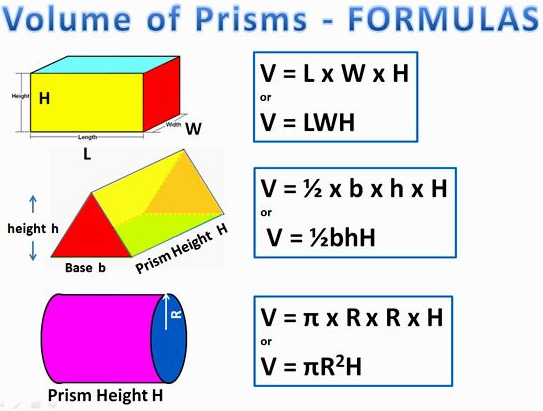The volume of a prism is the capacity of the prism. There can be different types of prisms like a triangular prism, square prism, rectangular prism, pentagonal prism, hexagonal prism, or octagonal prism. But the method to write the formula of volume of any prism remains the same immaterial of the type of prism.
The concept of writing the formula for the volume of the prism stays the same in any case. Like all three-dimensional shapes, you will learn how to calculate the volume of any type of prism. Stay tuned to learn how to use its formula using solved examples.

Table of Contents
What is the Volume of Prism?
The volume of a prism is defined as the amount of space a prism occupies. A prism is a solid 3-D shape that has two same faces and other faces that resemble a parallelogram. It is a polyhedron whose naming convention is influenced by the different shapes of the bases.
In the case of prisms, every prism has a different base, triangular prism (triangular base), square prism (square base), rectangular prism (rectangular base), pentagonal prism (pentagonal base), hexagonal prism (hexagonal base), or an octagonal prism (octagonal base).
Thus, as each prism is a three-dimensional shape, the volume of every prism also lies in a three-dimensional plane. The unit of volume of a prism is given as cubic meters, cubic centimeters, cubic inches or cubic feet, etc.
The formula of Volume of Prism
The formula for the volume of a prism is given by the product of the area of the base and height of the prism.
Thus, as the bases of different types of prisms are different so are the formulas to determine the volume of the prism.
Thus, the volume of a prism can be given as V = B × H where V is the volume, B base area, and H height of the prism. The unit of base area is given in square units and the height of the prism is given in units. Thus, the unit of volume of the prism is given as V = (square units) × (units) = cubic units.
How to Calculate the Volume of Prism?
The steps to determine the volume of the prism are:
- Step 1: Write the given dimensions of the prism.
- Step 2: Determine the volume of the prism using the formula V = B × H where V, B, and H are the volume, base area, and height of the prism.
- Step 3: The value of the volume of the prism is once obtained then add the unit of volume of prism in the end (in terms of cubic units).
Example: Find the volume of a prism whose base area is 3 square inches and height is 7 inches.
Solution: As we know, the volume of the prism is V = B × H.
Given that: B = 3 square inches, H = 7 inches
Thus, the Volume of the prism, V = B × H ⇒ V = 3 × 7 = 21 in3
Therefore, the volume of the prism is 21 cubic inches.
FAQs
The amount of space occupied by a prism is referred to as the volume of a prism. The volume of the prism depends on the base radius of the prism and the height of the prism. The unit of volume of the prism is expressed in m3, cm3, in3, or ft3.
The formula for the volume of a prism is obtained by taking the product of the base area and height of the prism. The volume of a prism is given as V = B × H where, “V” is the volume of the prism, “B” is the base area of the prism, and “H” is the height of the prism.
We can find the volume of the prism using the following steps:
Step 1: First write the given dimensions of the prism.
Step 2: Find the volume of the prism using the formula V = B × H where “V”, “B”, and “H” are the volume, base area, and height of the prism.
Step 3: Once the value of the volume of the prism is obtained, write the unit of volume of prism in the end (in terms of cubic units).
The steps to determine the base area of the prism, if the volume of the prism is given, are:
Step 1: Write the given dimensions of the prism.
Step 2: Substitute the given values in the formula V = B × H where “V”, “B”, and “H” are the volume, base area, and height of the prism.
Step 3: Now solve the equation for “B”.
Step 3: Once the value of the base area of the prism is obtained, write the unit of the base area prism in the end (in terms of square units).
